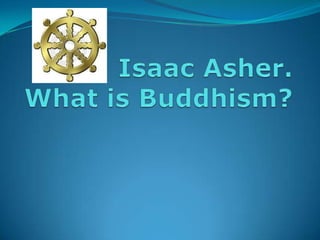
Buddhism.
- 1. Isaac Asher.What is Buddhism?
- 2. INTRODUCTION. For more than 2,500 years, the religion we know today as Buddhism has been the primary inspiration behind many successful civilizations, the source of great cultural achievements and a lasting and meaningful guide to the very purpose of life for millions of people. Today, large numbers of men and women from diverse backgrounds throughout our world are following the Teachings of the Buddha. So who was the Buddha and what are His Teachings?
- 3. THE BUDDHA! The man who was to become the Buddha was born around 2,600 years ago as a Prince of a small territory near what is now the Indian-Nepalese border. Though he was raised in splendid comfort, enjoying rich status, no amount of material pleasure could satisifythe nature of the young man. At the age of 29 he left the palace and his family to search for a deeper meaning in the secluded forests and remote mountains of North-East India. He studied under the wisest religious teachers and philosophers of his time, learning all they had to offer, but he found it was not enough. He then struggled alone with the path of self- mortification, taking that practice to the extremes of asceticism, (wich is also known as hedonism) but still to no avail. Then, at the age of 35, on the full moon night of May, he sat beneath the branches of what is now known as the Bodhi Tree, in a secluded grove by the banks of the river Neranjara, and developed his mind in deep but luminous meditation. Using the extraordinary clarity of such a mind with its sharp penetrative power generated by states of deep inner stillness, he turned his attention to investigate upon the hidden meanings of the mind, universe, and life. Then he gained the supreme Enlightenment experience and from that time on he was known as the Buddha. His Enlightenment consisted of the most profound and all-embracing insight into the nature of the mind and all phenomena. This Enlightenment was not a revelation from some divine being, but a discovery made by Himself, and based on the deepest level of meditation, and the clearest experience of the mind. It meant that He was no longer subject to craving, ill-will and delusion world, but was free from their shackles, having gained the complete ending of all forms of inner suffering, and acquired unshakeable peace.